Sculptra
Sculptra is a dermal filler that can provide long lasting, natural looking results
Sculptra is a unique dermal filler made from an FDA-approved, biocompatible synthetic substance called poly-L-lactic acid (PLLA). Poly-L-lactic acid promotes the gradual production of new collagen in treated areas, helping to restore volume loss and smooth fine lines and wrinkles. Sculptra injections can be administered to the face, neck, jawline, hands, chest, décolletage, hips, and buttocks to address various skin concerns and achieve optimal facial rejuvenation and body contouring results. With minimal downtime, few potential side effects, and consistently natural-looking, long-lasting results, Sculptra is one of the most popular injectable treatments at Dr. Michele Green’s private Upper East Side dermatology practice in New York City.
Collagen is the most abundant protein in the skin, contributing to a firm, smooth texture and a more youthful appearance. It naturally decreases at a rate of 1% per year after age 20, which can cause signs of aging and exacerbate other skin issues, such as acne scars, cellulite, and stretch marks. Replenishing collagen with Sculptra can help address these concerns, as well as reduce facial wrinkles and fine lines, restore facial volume, and tighten the skin. Sculptra is often used in conjunction with other injectable treatments, such as Botox or hyaluronic acid fillers like Juvederm and Restylane, in what is known as a ‘liquid facelift’ for overall facial rejuvenation. However, unlike hyaluronic acid fillers, Sculptra cannot be dissolved or removed after injection. Therefore, Sculptra should only be administered by an experienced injector, such as Dr. Green, to ensure the best results.
Dr. Michele Green is an internationally renowned, board-certified dermatologist with over 25 years of experience offering some of the world’s most discerning individuals highly effective non-invasive cosmetic treatments, including Sculptra injections for facial rejuvenation and body contouring. Dr. Green takes a holistic approach, adopting a less-is-more philosophy, and customizes each patient’s treatment plan to address their unique skin concerns and achieve their aesthetic goals. She is consistently recognized as one of NYC’s top dermatologists by Castle Connolly, New York Magazine, The New York Times, and Super Doctors for her dedication to her patients and her expertise. When you meet with Dr. Green at her private, boutique dermatology practice in Manhattan’s Upper East Side, she will collaborate with you to create a treatment plan that delivers natural-looking, long-lasting results so you can look and feel your best.
What is Sculptra treatment?
Sculptra is a dermal filler designed to gradually restore skin by promoting new collagen growth in the treated area. It contains poly-L-lactic acid, a safe collagen stimulator known for restoring facial volume loss. This innovative liquid injectable was first FDA-approved in 2004 to treat lipoatrophy (localized fat loss) in people with HIV. The impressive cosmetic results from Sculptra treatments led to its FDA approval for aesthetic use in 2009. Sculptra is used to improve various skin concerns on the face and body, including fine lines, acne scars, facial volume loss, hollow areas, mild skin laxity, cellulite, and stretch marks. As the treatment encourages new collagen production, it results in smoother, firmer skin and a more naturally youthful appearance. Sculptra can provide long-lasting results in facial rejuvenation and body contouring, with effects lasting up to two years after a series of injections.
When choosing a cosmetic procedure for facial rejuvenation and body contouring, many patients prefer non-invasive Sculptra injections over plastic surgery, which can be costly, carry risks and side effects, and require significant recovery time. Sculptra injections are relatively quick and painless, with minimal downtime, and consistently produce natural-looking, impressive results. Sculptra is one of Dr. Michele Green’s favorite dermal fillers because of its versatility and long-lasting, natural-looking effects.
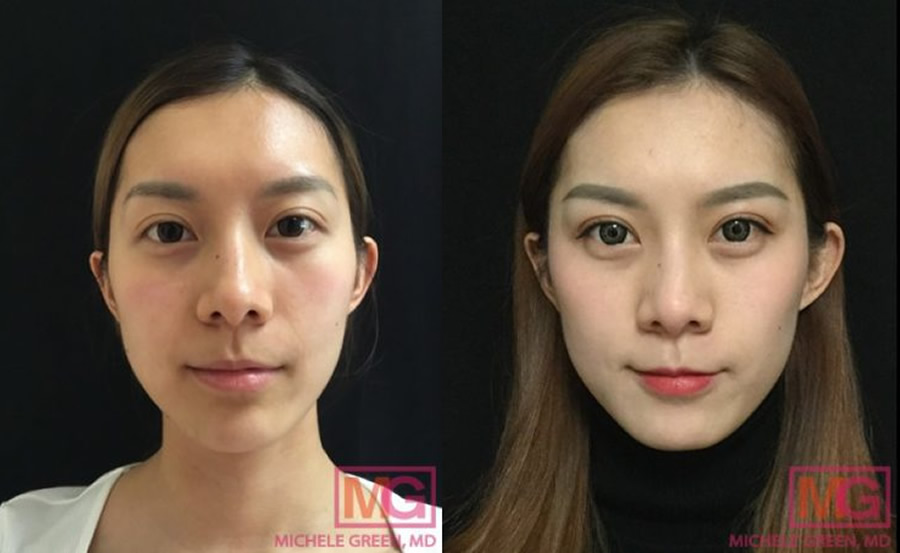
What is Sculptra injectable made of?
Sculptra is a collagen stimulator made from poly-L-lactic acid (PLLA). PLLA is a well-established material that has been used in medical products for over 20 years and is commonly found in dissolvable sutures and surgical implants. Sculptra is a biocompatible, synthetic injectable that uses PLLA to encourage the production of new collagen in the treatment area. PLLA is not permanent, and over time, it is gradually broken down and naturally eliminated from the body.
How does Sculptra work?
Sculptra is a liquid injectable treatment that offers a natural-looking, long-lasting rejuvenation by stimulating the body’s collagen production in the treated areas. Its active ingredient, poly-L-lactic acid, activates collagenase activity once injected. Collagen, the most abundant protein in the skin, helps create a firm, smooth texture and a youthful appearance overall. Naturally, collagen production decreases about 1% each year after age 20. This decline can cause and worsen the appearance of fine lines, cellulite, stretch marks, and facial volume loss, among other signs of aging. By restoring collagen levels in the treated areas, Sculptra can result in smoother, tighter, firmer, and more youthful-looking skin, with fewer visible signs of aging. It usually takes 4 to 6 weeks to see results from Sculptra injections. Most patients need at least three sessions, spaced about one month apart, to achieve optimal results. The effects typically last around two years, with many patients choosing to have annual maintenance treatments to preserve their results. When you consult with board-certified dermatologist Dr. Green at her private practice in NYC, you will develop a personalized Sculptra treatment plan tailored to your needs and goals.
What does Sculptra do?
Sculptra is a popular and versatile dermal filler used for non-invasive facial rejuvenation and body contouring. With an expert injector like Dr. Green in NYC, Sculptra improves the appearance of fine lines, facial volume loss, acne scars, skin laxity, stretch marks, cellulite, and body hollows. It also restores or adds volume and contour to various areas, including the midface, temples, chin, jawline, cheeks, décolletage, chest, neck, hips, knees, upper arms, and buttocks. To determine what Sculptra can do for you, it’s best to consult an experienced, board-certified cosmetic dermatologist like Dr. Michele Green in NYC. Dr. Green is an internationally renowned expert in cosmetic dermatology with over 25 years of experience providing top non-invasive cosmetic procedures to patients in the Upper East Side of Manhattan, including Sculptra injections for facial rejuvenation and body contouring. She will work with you to create an injectable treatment plan tailored to your individual needs.
Where is Sculptra injected?
Sculptra can be injected in the following treatment areas:
- Cheeks
- Temples
- Marionette lines
- Nasolabial folds (smile lines)
- Facial jowls/ jawline
- Chin wrinkles
- Décolletage
- Buttocks
- Hip dips
- Hands
- Inner arms
- Upper knees
- Stretch marks
- Cellulite
Sculptra for age-related facial volume loss and creases
Collagen is a vital structural component that provides essential support and a firm foundation for a supple, smooth, and youthful-looking complexion. As part of the natural aging process, collagen in the skin breaks down, leading to signs of aging such as facial wrinkles, fine lines, skin laxity, and volume loss. Sculptra is a new dermal filler injection that acts as a gradual collagen stimulator, effectively reducing facial wrinkles and fine lines while restoring volume. Unlike other treatments, Sculptra not only diminishes fine lines and wrinkles but also improves skin firmness and quality over time, resulting in a naturally youthful appearance that lasts for several months. Sculptra injections can be administered in the cheeks, chin, jowls/jawline, temples, nasolabial folds, and marionette or smile lines to achieve a comprehensive facial refresh.
Sculptra for acne scars
Acne scars form when inflammation associated with active acne causes permanent damage to the skin underneath. During the natural wound-healing process, collagen is produced. When insufficient collagen is generated during this process, depressed or atrophic acne scars develop. Patients with these scars on the temples, cheeks, chin, and jawline can benefit greatly from Sculptra treatment, which helps restore lost collagen to these areas. To achieve the best results in acne scar reduction, most patients require a series of 3-6 Sculptra sessions, each spaced about one month apart. The total number of sessions needed will depend on the severity of the scars.
Sculptra injections for hip dips
The term ‘hip dips’ refers to the indentations where the hips meet the outer thighs. Some women have hip dips, while others do not, mainly due to their genetic makeup and pelvic bone structure. Although hip dips are completely natural and normal, many women desire a fuller, rounder hip shape. Sculptra is an excellent dermal filler that helps create a more rounded hip area and achieve a more hourglass figure. It works by stimulating new collagen production, which gradually fills in the hollows of the hip dips over time. As a non-invasive aesthetic treatment, Sculptra is ideal for individuals seeking to enhance their hip shape without surgery. Additionally, Sculptra treatments require no downtime, allowing patients to return to their daily activities immediately after the injections.
Sculptra for non-surgical Brazilian Butt Lift
Sculptra BBL is a popular alternative to plastic surgery for enhancing the shape, firmness, and volume of the buttocks. Sculptra injections offer patients a non-surgical option for the Brazilian Butt Lift, making it ideal for those wanting to improve their buttocks without invasive surgery, anesthesia, or downtime. When it comes to buttock augmentation, Sculptra treatment can be customized to meet each person’s aesthetic goals, whether they prefer a subtle lift and a V-shaped buttock profile or a more dramatic “Kardashian” look. A Sculptra BBL is also a great choice for individuals with limited excess fat in other areas of their body who aren’t candidates for a surgical BBL, which typically involves a fat transfer. It’s important to note that Sculptra for the buttocks is not FDA-approved and is considered “off-label,” so having your Sculptra BBL performed by an experienced, board-certified dermatologist like Dr. Green is crucial to minimize side effects and achieve optimal body contouring results.
Sculptra for hand rejuvenation
During the natural aging process, collagen and elastin in the hands decrease, causing crepey skin texture and more visible tendons and veins. One of the most effective cosmetic treatments for improving these skin concerns on the backs of the hands with minimal downtime is dermal filler injections, such as those with Sculptra. As an “off-label” treatment, Sculptra gradually restores a natural-looking volume by stimulating fibroblasts to produce collagen. For hand rejuvenation, most patients need three to four sessions, spaced four weeks apart, to achieve optimal results.
Sculptra for neck rejuvenation
The skin on the neck and décolletage contains less natural collagen compared to other areas of the face and body. Some patients are genetically predisposed to develop horizontal neck lines, while others may develop them from ‘tech neck’ caused by looking down at phones or screens. As collagen production decreases and existing collagen deteriorates with age, increased skin laxity and volume loss tend to make fine lines and creases more noticeable, especially on the neck, leading to a hollow appearance and a crepey skin texture. Fortunately, Sculptra injections can help reduce or eliminate the appearance of horizontal neck lines. Most patients require a series of three treatments to achieve optimal neck rejuvenation results.
Sculptra for cellulite treatment
Cellulite is a common skin condition caused by the tension between bulging fat cells and the fibrous cords connecting the skin to the muscle, creating a lumpy, dimpled look on the skin’s surface. Up to 90% of women will experience cellulite, and for many, it can be a source of frustration and low self-esteem. By stimulating new collagen production, Sculptra injections can improve the appearance of cellulite dimples and ripples. Over time, the collagen produced by the treatment will help fill in the dimples, resulting in smoother skin.
Sculptra treatment for stretch marks
Stretch marks are scars in the dermis that form when the skin stretches or shrinks rapidly. Excessive or quick stretching can damage collagen and elastin proteins, leading to the development of stretch marks. Possible causes include hormonal changes, genetics, rapid growth spurts, pregnancy, weight gain or loss, and sudden increases in muscle size. Sculptra can be injected into depressed stretch marks to stimulate new collagen growth, helping to restore volume, smooth the skin’s texture, and enhance skin elasticity.
Who is a good candidate for Sculptra injectable treatment?
An ideal candidate for Sculptra injections should be in good overall health and at least 18 years old. Sculptra treatment can be an excellent choice for patients seeking long-lasting cosmetic results without invasive surgery. Patients may not qualify if they have a history of severe allergic reactions, keloids, hypertrophic scarring, or allergies to poly-L-lactic acid, lidocaine, or other ingredients in Sculptra. Those with an active infection, acne breakout, or rash in the treatment area should wait until the skin concern has healed to reduce the risk of worsening the condition. Additionally, pregnant or breastfeeding women should avoid Sculptra injections since its safety has not yet been confirmed. The best way to determine if you are a good candidate is to consult a board-certified dermatologist, such as Dr. Green. When you meet with Dr. Green at her private dermatology office in Manhattan’s Upper East Side, she will review your medical and family history, perform a skin exam, and discuss your concerns and goals to see if Sculptra is suitable for you.
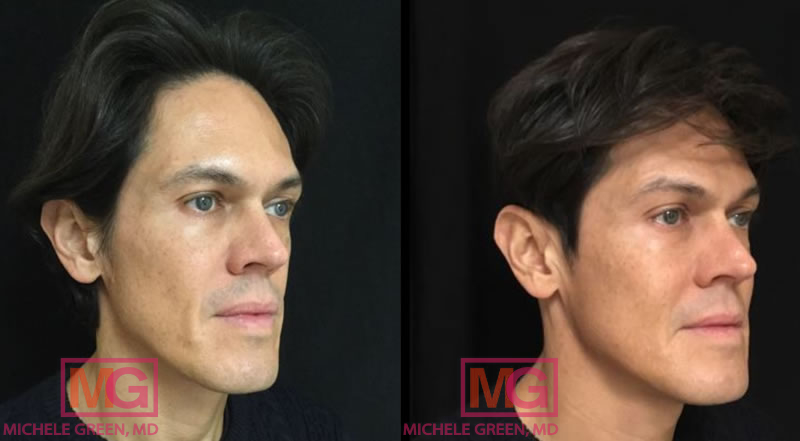
What is the process like for Sculptra treatment?
The first step involves consulting with board-certified dermatologist Dr. Michele Green at her private office in Manhattan’s Upper East Side. During your consultation, Dr. Green will take a detailed medical history, physically examine the potential treatment areas, and review any previous cosmetic procedures you may have had. Medical photographs may be taken to track your progress over time. If you are a candidate for Sculptra, the procedure can be done on the same day as your consultation or scheduled for a later date, depending on your preferences and availability.
To prepare for treatment, patients should stop using blood-thinning agents, including Aspirin, Motrin, Advil, Aleve, multivitamins, fish oil, and vitamin E, one week before the procedure to help prevent bruising. Dr. Green also recommends taking oral Arnika Forte, an herbal supplement, for three to four days to help prevent bruising and speed up healing, both before and after your Sculptra injections.
On the day of your Sculptra treatment, patients should apply a topical anesthetic cream to the entire treatment area one hour before the procedure to reduce discomfort. When you arrive at Dr. Green’s private NYC dermatology office, the anesthetic cream will be removed, and your skin will be sterilized. Dr. Green will skillfully inject the Sculptra into the target area. Afterwards, the area will be massaged for five minutes. Following the treatment, patients should follow the “rule of 5’s”: massage the treatment area five times daily for five minutes over five consecutive days.
What is the downtime for Sculptra treatment?
One of the main benefits of Sculptra treatment is the minimal downtime required. Since Sculptra is a non-invasive cosmetic procedure, patients can resume their normal daily activities immediately after injections. Common side effects include mild swelling, redness, and bruising in the treated areas, which usually resolve on their own within one to two weeks. To reduce the risk of additional swelling, patients should avoid strenuous exercise and heat exposure, such as hot tubs and saunas, for 48 hours. They should also avoid blood thinners, including NSAIDs, multivitamins, fish oil, and vitamin E, for a week to help prevent bruising. Taking Arnika herbal supplement for an extra three to four days may also help prevent and accelerate healing.
How to massage Sculptra
The key part of aftercare for Sculptra treatment is massaging the treated area. After Sculptra injections, patients should massage the area for five consecutive days, five times a day, for five minutes each session. Massaging helps ensure the filler distributes evenly and reduces the risk of nodules forming. Patients should massage in small, circular motions, moving outward and upward. Using a moisturizer or lotion can help fingers glide smoothly over the treatment site. When you receive Sculptra treatment at Dr. Green’s private dermatology office in the Upper East Side, your first massage will be performed after the injections.
What are the side effects of Sculptra injections?
The most common side effects of Sculptra injections include mild swelling, bruising, tenderness, or redness at or near the injection sites. These side effects are typically mild and usually go away on their own within two weeks of treatment. Less common potential side effects of Sculptra injections include skin discoloration and the delayed appearance of nodules.
Lumps or bumps near the injection sites are common with Sculptra nodules, which can form due to improper product dilution, poor injection technique, or not massaging the treatment area afterward. Sculptra nodules cannot be dissolved, so patients must wait for them to disappear naturally, a process that can take several years. In severe cases, patients may need a plastic surgeon to remove any Sculptra nodules. To lower the risk of developing Sculptra nodules or other unwanted side effects, it is important to consult with an expert injector, such as board-certified dermatologist Dr. Michele Green, who has the knowledge and experience to safely and effectively give your Sculptra injections.
When does Sculptra start working?
Sculptra is a collagen stimulator that gradually revitalizes your skin’s youthful look. You will begin to notice initial results within four weeks of your first Sculptra treatment. The body continues to produce new collagen for up to six weeks after the injections. Most patients need a series of treatments, usually three, to achieve the best results. Dr. Green will assess your progress during each follow-up to ensure you’re on track to reach your goals.
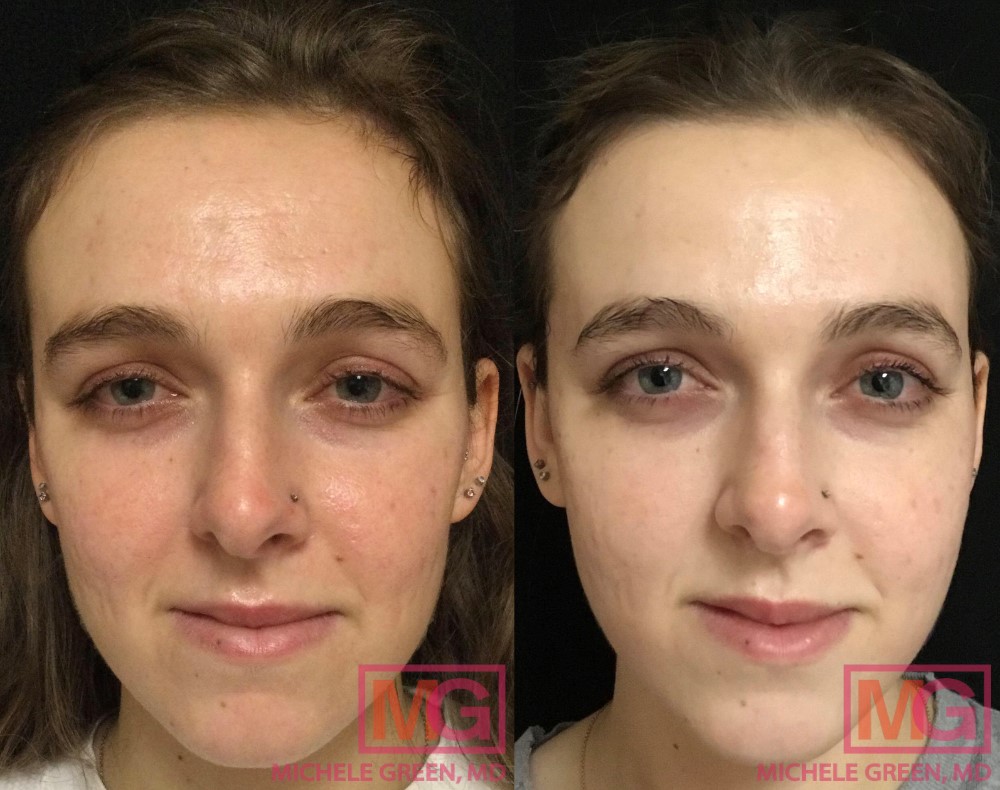
How long do Sculptra injections last?
Patients often need a series of three or more Sculptra sessions to achieve the best results. Sculptra results are not permanent; however, it can provide rejuvenating effects for two years or longer. Many patients prefer Sculptra over hyaluronic acid fillers because of its consistently impressive and long-lasting rejuvenation effects.
How often should you get Sculptra?
Many patients opt for an annual maintenance session to continue maximizing the cosmetic benefits of Sculptra. Those with more severe volume loss or skin laxity might need more frequent sessions to preserve and improve their results.
Is Sculptra safe?
Absolutely! The United States Food and Drug Administration approved Sculptra in 2004 for correcting lipoatrophy (facial fat loss) in patients with HIV. Sculptra was then FDA-approved in 2009 for aesthetic use, following extensive clinical studies that demonstrated the treatment’s safety and effectiveness for cosmetic purposes. Sculptra is a non-invasive injectable treatment that consistently delivers natural-looking, long-lasting, and ideal cosmetic results with minimal downtime and side effects.
Sculptra should always be administered by a board-certified dermatologist, such as Dr. Michele Green in NYC, who has the expertise and experience necessary to perform the procedure safely and effectively. With over 25 years of experience in cosmetic dermatology, Dr. Green provides high-quality, non-invasive treatments, including ‘liquid facelifts’ with dermal fillers like Sculptra. When you consult with Dr. Green about Sculptra for facial rejuvenation or body contouring, she will create a personalized treatment plan to help you look and feel your best again.
Does Sculptra really work?
Yes! Sculptra Aesthetic is an excellent dermal filler that helps restore your natural collagen. Sculptra is an injectable treatment that uses poly-L-lactic acid to stimulate the production of new collagen in the skin, resulting in a smoother, more youthful look. Patients appreciate that Sculptra treatment is a gradual process, allowing them to achieve a natural-looking rejuvenation. Clinical studies have shown Sculptra’s effectiveness in improving skin radiance, firmness, and tightness, as well as creating a more contoured appearance. Sculptra can be used to address volume loss, fine lines, and folds that appear on the cheeks, lower face, temples, and jawline, as well as on the neck, chest, buttocks, and hip dips. Most patients need a short series of Sculptra injections to reach their desired cosmetic results, and the effects usually last up to two years. The cosmetic benefits of Sculptra can be maintained through regular follow-up treatments scheduled to fit your personal needs and aesthetic goals.
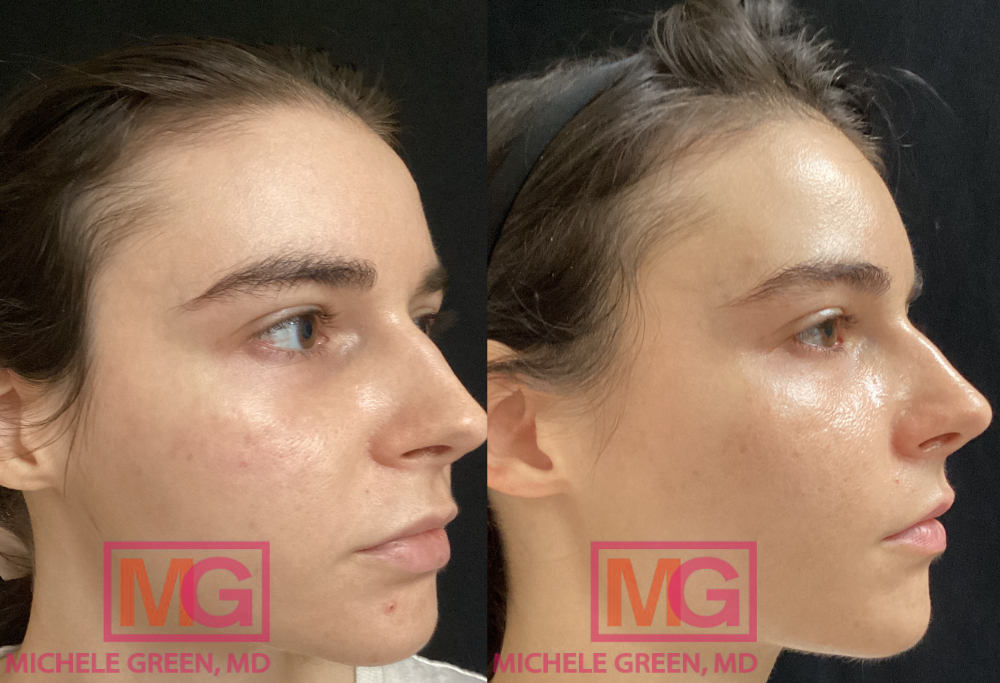
Frequently Asked Questions (FAQs) about Sculptra dermal fillers
Who makes Sculptra?
Sculptra is made by the pharmaceutical company Galderma. Galderma also offers over-the-counter products, prescription medications, and other aesthetic solutions. Regarding injectable treatments, Galderma produces the Restylane line of hyaluronic acid dermal fillers and Dysport, an injectable treatment similar to Botox.
Is Sculptra a filler?
Yes! Sculptra is a dermal filler that effectively restores volume loss in various facial and body areas. Sculptra was first FDA-approved in 2004 solely to treat lipoatrophy, or fat loss, in patients with HIV, and was used on these individuals to stimulate natural collagen production and help restore lost facial volume. The success of Sculptra in treating lipoatrophy led to FDA approval in 2009 for aesthetic purposes in healthy patients. Its safety and effectiveness as a cosmetic treatment are well-established, making it a highly popular dermal filler with many uses.
Is Sculptra a biostimulator?
Yes, Sculptra is considered a biostimulator because it encourages the growth of new collagen in the skin. Collagen is the most common protein in the skin, helping to keep it firm, support its structure, and retain a more youthful look. When injected, the poly-L-lactic acid in Sculptra creates a supporting framework that stimulates new collagen production in the treated area.
Where can Sculptra be injected?
Sculptra is a dermal filler suitable for various facial and body areas. Common facial treatment sites include the cheeks, marionette lines, nasolabial folds, temples, chin, and jawline. Typical areas on the body include the neck, chest, décolletage, hip dips, buttocks, upper knees, stretch marks, and cellulite.
Where to inject Sculptra in the face?
Sculptra is usually injected into the cheeks and temples to treat age-related volume loss, as well as volume loss caused by rapid weight loss or acne scars. It can also be injected into marionette lines and nasolabial folds, often called smile lines, to address folds and creases resulting from skin laxity and volume loss. In addition, Sculptra may be injected into the chin and jawline to enhance contour, definition, and facial symmetry.
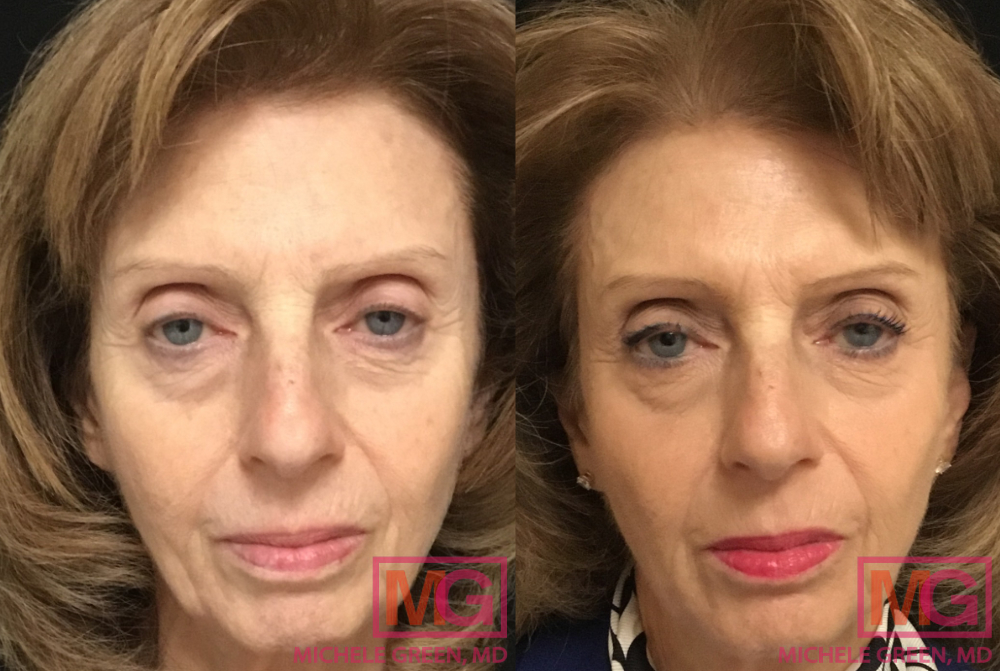
Can Sculptra be used under the eyes?
No, it is not advisable to use Sculptra in the under-eye area. The skin under the eyes is very delicate, and injecting Sculptra there can lead to the formation of nodules or lumps. To treat undereye hollows, Dr. Green prefers using other dermal fillers, such as Restylane and Belotero. These fillers are made from hyaluronic acid, a naturally occurring substance that helps keep the skin supple and full. When injected, hyaluronic acid fillers provide immediate volume restoration to the area. The effects of hyaluronic acid fillers can last from six to twelve months, depending on the specific product used.
When does Sculptra peak?
Sculptra is a distinctive dermal filler that gradually rejuvenates the skin by encouraging the body’s natural collagen production. The collagen-boosting effects of Sculptra typically reach their peak within 3 to 6 months after injection. Most patients need an initial series of approximately three Sculptra treatments, each spaced roughly one month apart, to achieve the best results. Once the desired outcome is achieved, the cosmetic benefits of Sculptra can last up to two years.
Is Sculptra permanent?
No. While Sculptra treatment is not permanent, it provides long-lasting results for skin rejuvenation. Studies show that the effects of Sculptra last over two years after a short series of treatment sessions, enabling full correction. Maintenance treatments are needed to restore volume and encourage new collagen production over time. Patients often appreciate that because Sculptra isn’t permanent, they can adjust their treatments to fit their changing concerns and aesthetic goals, helping them continue to look and feel their best.
Does Sculptra hurt?
Many patients often wonder, “Is Sculptra painful?” and the answer is no! Sculptra is a liquid injectable treatment mixed with lidocaine, a local anesthetic, right before injections to help minimize any potential discomfort during the procedure. Additionally, Dr. Green prescribes a topical anesthetic cream for her patients to apply to the entire treatment area one hour before their appointment. When you arrive at Dr. Green’s private dermatology office in Manhattan’s Upper East Side, the numbing cream is removed, and the skin is sterilized. Most patients experience little to no discomfort during their injectable treatment.
When do Sculptra nodules appear?
Nodules are a rare potential side effect of Sculptra, characterized by firm, raised lumps or bumps near the injection sites. They may be visible or felt under the skin. Sculptra nodules can form due to improper product dilution, injection technique, or failure to massage the area as directed by your provider after injections. If they develop, nodules typically appear several months after treatment. Some reports suggest that corticosteroid injections can reduce nodules, while others indicate that it may take years for them to resolve naturally. To prevent nodule formation and achieve the best cosmetic results, Sculptra injections should always be administered by an experienced, board-certified dermatologist, such as Dr. Michele Green in NYC.
Does Sculptra migrate?
The molecular structure of Sculptra prevents it from migrating. However, Sculptra is a liquid dermal filler that requires specific aftercare instructions to achieve the best results. After Sculptra injections, you should massage the treatment area five times a day, for five minutes each time, for five days in a row. This helps evenly distribute the dermal filler throughout the area, leading to optimal cosmetic results and reducing the risk of unwanted side effects, such as nodule formation. Sculptra nodules develop when new collagen forms in clusters, creating firm lumps in the skin that may or may not be visible. Because Sculptra cannot be dissolved or easily removed once injected, it’s important to have the procedure performed by an experienced, board-certified dermatologist, like Dr. Green in NYC, who has the expertise to ensure ideal results and reduce the chance of side effects.
Can Sculptra be dissolved?
Sculptra cannot be dissolved after injections because its effect relies on the production of new collagen. Sculptra’s results can last up to two years, and since it cannot be removed or reversed, it must be administered correctly from the start. If nodules form in the treatment area, options for treatment are limited. Usually, these nodules resolve on their own over time, although this process can take several years. Some reports suggest that cortisone injections may help reduce Sculptra nodules, but this is not guaranteed or always effective. The final option is surgical removal of the nodule by a plastic surgeon. Because none of these options are ideal, it’s important to have your initial Sculptra injections performed by an experienced, board-certified dermatologist. Dr. Michele Green, a renowned board-certified dermatologist in New York City, has over 25 years of experience providing innovative, non-invasive cosmetic treatments, including Sculptra. When you consult with Dr. Green, she will work with you to ensure your Sculptra treatment achieves the best possible cosmetic results.
How much does Sculptra cost?
Several factors, including the size of the treatment area and the number of vials needed for Sculptra, influence the overall cost of the procedure. Additionally, the experience level of your healthcare provider and the geographic location of the office can affect the price. Sculptra treatments performed by an expert injector, such as board-certified dermatologist Dr. Michele Green in New York, will typically cost more than those administered by a nurse injector at a medical spa. However, having an expert perform your injections is crucial to avoid unwanted side effects, such as nodule formation, and to ensure the best cosmetic results. The most accurate way to determine the total cost is to consult with Dr. Green. During your consultation, she will assess the treatment area and estimate the number of Sculptra vials needed for your procedure. At that point, the cost can be roughly calculated.
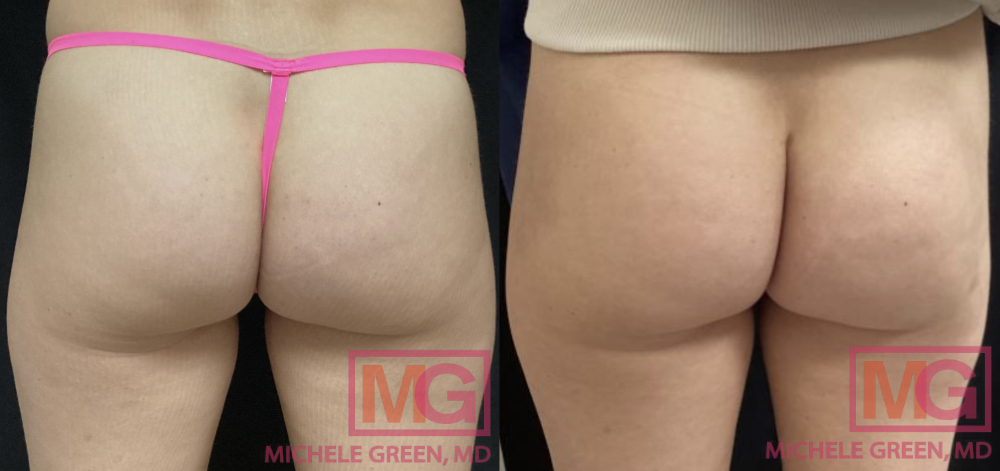
How much is Sculptra for the face, butt, or hips?
The cost of Sculptra injections varies based on the treatment area. Sculptra is typically priced per vial, and the number of vials needed depends on the patient’s age, size, the size of the treated area, and the severity of the skin concerns. On average, patients may need one or two vials for the face, five or more for each buttock, and three or more for each hip dip. Younger individuals and those with mild to moderate skin issues might require fewer vials, while older patients and those with more severe problems may need more. Most patients undergo a series of at least three treatment sessions to achieve the best results, though those with more significant concerns might require additional treatments.
The best way to determine the cost of your Sculptra injections and how many vials you’ll need to achieve your personal goals is to consult an expert Sculptra injector, like Dr. Green in NYC. Dr. Green is a highly respected, board-certified dermatologist with over 25 years of experience tailoring each patient’s injectable treatment plan. During your consultation, Dr. Green will assess the treatment area to estimate the number of vials required and craft a personalized treatment plan suited to your needs.
Is Sculptra better than other dermal fillers?
No one dermal filler is inherently better than another. Sculptra and other dermal fillers, including Juvederm, Restylane, and Belotero, all offer impressive rejuvenation results with little to no downtime. Sculptra is unique because it restores volume loss by gradually stimulating the production of new collagen in the skin, unlike hyaluronic acid fillers that instantly plump the skin. Since hyaluronic acid fillers provide immediate results, patients often need only one treatment session to meet their cosmetic goals, depending on their specific concerns. Usually, a series of three Sculptra treatments is necessary to achieve optimal results, and more sessions may be required for more severe cosmetic issues. Although it works gradually, the results can last up to two years, which is longer than many popular hyaluronic acid dermal fillers, typically lasting 6-12 months.
Consulting an experienced, board-certified dermatologist like Dr. Green in NYC is the best way to determine whether Sculptra or another dermal filler fits your needs. In fact, Sculptra and hyaluronic acid fillers are often used together during the same treatment session to target different concerns. For example, a patient with facial volume loss who also wants lip augmentation might benefit from using Sculptra in the cheeks and lower face, along with a hyaluronic acid filler in the lips. When you meet with Dr. Green at her private dermatology office in Manhattan’s Upper East Side, she will physically examine the areas of concern, review any previous cosmetic treatments, and discuss your aesthetic goals to identify the best combination of dermal fillers for your situation so you look and feel like the best version of yourself.
Is Sculptra worth it?
With so many dermal fillers available today, patients often ask, “Should I get Sculptra? Is it worth it?” The answer is yes! Sculptra is a very popular dermal filler that provides unmatched facial rejuvenation and body contouring results. Sculptra injections offer a non-invasive cosmetic option to address various skin concerns, delivering natural-looking and long-lasting benefits. Treatment with Sculptra Aesthetic may be the ideal solution for those seeking a natural way to improve volume loss, fine lines, facial wrinkles, acne scars, stretch marks, cellulite, or hollowness. After a short series of injections, patients can expect excellent results lasting up to two years. One of the main advantages of Sculptra is its gradual effect, which creates consistently natural-looking results and allows patients to customize treatments to their changing skin needs. Patients agree that Sculptra injections, administered by an expert injector like board-certified cosmetic dermatologist Dr. Michele Green in NYC, are definitely worth it.
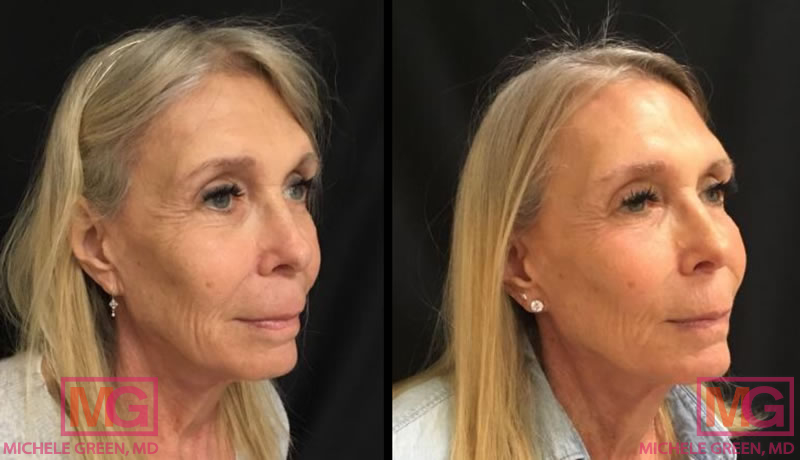
How to get started with Sculptra treatments in New York City with Dr. Michele Green
Sculptra is a unique dermal filler that can enhance facial rejuvenation and body contouring by gradually stimulating new collagen production. Collagen in the skin helps maintain a firm, smooth, tight skin texture, and a youthful look, but it naturally decreases after age 20. By replenishing or adding collagen to a treatment area, Sculptra can improve the appearance of fine lines, facial wrinkles, loss of facial volume, acne scars, skin laxity, cellulite, stretch marks, uneven texture, and hollows. Sculptra injections are a safe, effective, and long-lasting treatment, with results that can last up to two years after a series of treatments. With non-invasive Sculptra injections, Dr. Green can help you achieve radiant, youthful, and natural-looking cosmetic results.
Dr. Michele Green is a globally recognized, board-certified dermatologist with over 25 years of experience in providing top non-invasive cosmetic treatments to some of the world’s most discerning clients, including Sculptra for facial rejuvenation and body contouring. Dr. Green takes a holistic approach and follows a less-is-more philosophy when it comes to rejuvenation, customizing each patient’s treatment plan and skincare routine to meet their unique needs and achieve their ideal aesthetic goals. She is consistently recognized as one of NYC’s top physicians by Castle Connolly, New York Magazine, The New York Times, and Super Doctors for her dedication and expertise. When you consult with Dr. Green, she will work with you to develop a personalized treatment plan that delivers natural-looking, long-lasting, and youthful results, helping you look and feel like the best version of yourself. To schedule a consultation with Dr. Green at her private dermatology office in Manhattan’s Upper East Side neighborhood, contact us online today or call the office at 212-535-3088.
 212-535-3088
212-535-3088